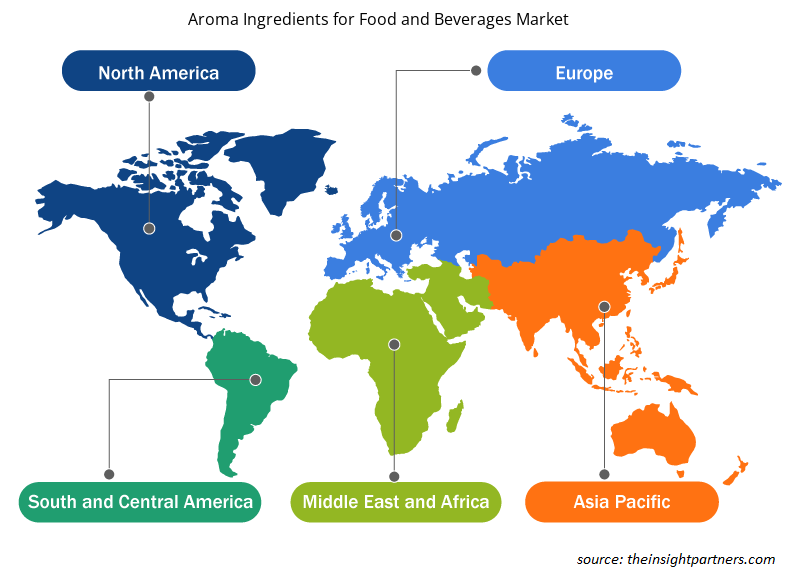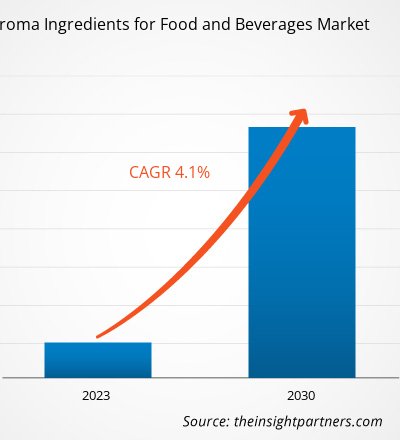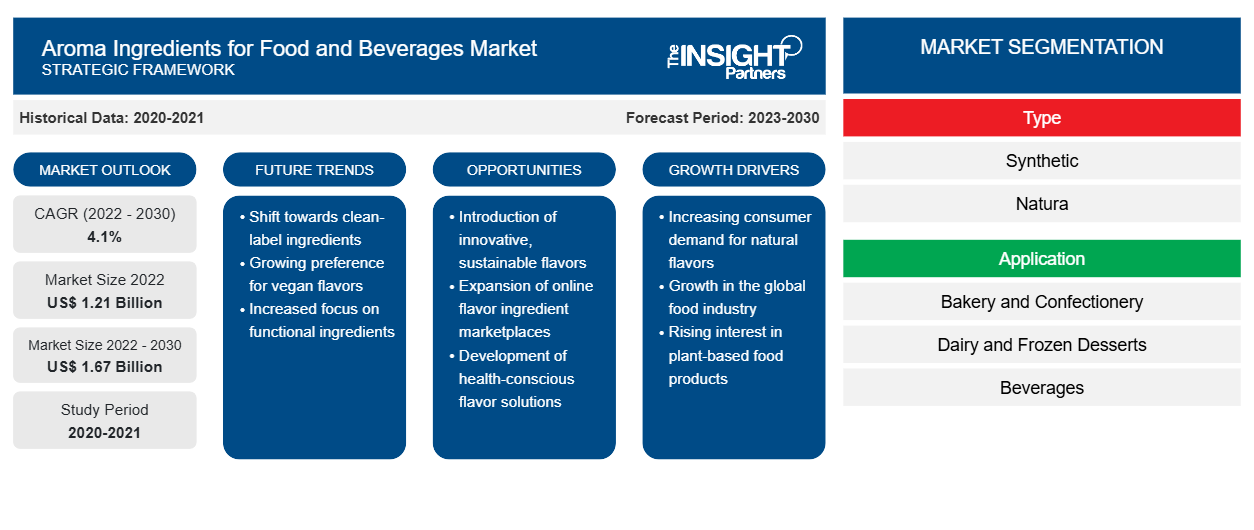[Rapporto di ricerca] Si prevede che il mercato degli ingredienti aromatici per alimenti e bevande crescerà da 1,21 miliardi di dollari nel 2022 a 1,67 miliardi di dollari entro il 2030; si stima che il mercato registrerà un CAGR del 4,1% dal 2022 al 2030.
Approfondimenti di mercato e punto di vista degli analisti:
Gli ingredienti aromatici sono isolati da ingredienti di origine naturale o estratti chimicamente dal petrolio. Questi ingredienti svolgono un ruolo cruciale nel modellare il profilo di sapore e aroma di vari prodotti alimentari e bevande, che vanno dai dolciumi e snack salati alle bevande alcoliche e analcoliche. La crescente importanza degli ingredienti aromatici nel settore alimentare e delle bevande e le iniziative strategiche dei principali attori del mercato sono i principali fattori che guidano gli ingredienti aromatici per il mercato alimentare e delle bevande. Inoltre, la crescente domanda dei consumatori di esperienze di sapore e aroma uniche ed esotiche, nonché i progressi nelle tecniche di estrazione e sintesi, contribuiscono ulteriormente a modellare il panorama del mercato. Tuttavia, i vincoli normativi associati all'uso di ingredienti aromatici nel settore alimentare e delle bevande ostacolano la crescita degli ingredienti aromatici per il mercato alimentare e delle bevande .
Fattori di crescita e sfide:
I produttori di ingredienti aromatici nel settore alimentare e delle bevande sono significativamente coinvolti in fusioni e acquisizioni, collaborazioni e altri sviluppi strategici per attrarre i consumatori e migliorare la loro posizione di mercato. La crescente domanda di ingredienti aromatici da parte di vari stabilimenti alimentari e delle bevande che producono e vendono prodotti da forno e dolciumi, latticini, dessert surgelati e altri articoli ha portato i principali attori ad adottare iniziative strategiche per rafforzare la loro posizione di mercato a livello globale. Ad esempio, a novembre 2023, BASF SE ha annunciato il lancio di due nuovi ingredienti aromatici naturali: Isobionics Natural alpha-Bisabolene 98 e Isobionics Natural (-)-alpha-Bisabolol 99. Tali sviluppi di prodotto stanno guidando gli ingredienti aromatici per il mercato alimentare e delle bevande.
I principali attori del mercato stanno espandendo i loro impianti di produzione e stipulando accordi con i distributori per rafforzare la loro posizione di mercato. Ad esempio, a dicembre 2021, Tilley Distribution, Inc. ha annunciato la fusione con Phoenix Aromas and Essential Oils. La fusione aiuterà a fornire prodotti di alta qualità a basi di consumatori nuove ed esistenti con team esperti nel fornire supporto normativo e tecnico. Inoltre, a luglio 2021, Symrise AG ha acquisito Giraffe Foods Inc. con sede in Canada, un produttore canadese di salse, intingoli, condimenti, sciroppi e concentrati per bevande personalizzati per clienti B2B. L'acquisizione amplierà il segmento Flavor & Nutrition di Symrise in Nord America, rafforzando la sua posizione di mercato e la sua base di clienti. Pertanto, le iniziative strategiche dei principali attori del mercato alimentano la crescita del mercato globale degli ingredienti aromatici per alimenti e bevande.
La produzione e l'uso di ingredienti aromatici in varie applicazioni alimentari e di bevande sono regolamentati da varie agenzie governative. Enti normativi come la Food and Drug Administration (FDA) e l'Autorità europea per la sicurezza alimentare (EFSA) impongono rigide linee guida e standard sull'uso di ingredienti aromatici per garantire la sicurezza dei consumatori e la qualità del prodotto. Ad esempio, il Programma delle Nazioni Unite per l'ambiente ha regolamentato l'uso di aromi alimentari. Questa regolamentazione prevede tutte le condizioni necessarie per l'uso corretto, controllato e sicuro di aromi e ingredienti aromatici o aromi negli alimenti. Inoltre, la Food and Drug Administration (FDA) ha imposto una regolamentazione sugli aromi alimentari che possono essere utilizzati negli e sugli alimenti. Il rispetto di questi requisiti normativi comporta ampi processi di test e documentazione, che possono richiedere molto tempo e denaro per i produttori. Il processo di approvazione per gli ingredienti aromatici può essere lungo e complesso, ostacolando ulteriormente l'innovazione e lo sviluppo del prodotto nel settore.
Personalizza questo report in base alle tue esigenze
Riceverai la personalizzazione gratuita di qualsiasi report, comprese parti di questo report, o analisi a livello nazionale, pacchetto dati Excel, oltre a usufruire di grandi offerte e sconti per start-up e università
- Scopri le principali tendenze di mercato in questo rapporto.Questo campione GRATUITO includerà analisi di dati che spaziano dalle tendenze di mercato alle stime e alle previsioni.
Segmentazione e ambito del report:
"Global Aroma Ingredients for Food and Beverages Market Analysis to 2030" è uno studio specializzato e approfondito con un'attenzione particolare alle tendenze di mercato e alle opportunità di crescita. Il rapporto mira a fornire una panoramica del mercato con una segmentazione dettagliata del mercato per tipo e applicazione. Il mercato ha assistito a una crescita elevata nel recente passato e si prevede che continuerà questa tendenza durante il periodo di previsione. Il rapporto fornisce statistiche chiave sul consumo di ingredienti aromatici per alimenti e bevande a livello globale. Inoltre, il rapporto di mercato globale degli ingredienti aromatici per alimenti e bevande fornisce una valutazione qualitativa di vari fattori che influenzano le prestazioni del mercato a livello globale. Il rapporto include anche un'analisi completa dei principali attori del mercato e dei loro principali sviluppi strategici. Sono incluse anche diverse analisi sulle dinamiche di mercato per aiutare a identificare i principali fattori trainanti, le tendenze di mercato e le opportunità redditizie che, a loro volta, aiuterebbero a identificare le principali sacche di entrate.
Gli ingredienti aromatici per le previsioni di mercato di alimenti e bevande sono stimati sulla base di vari risultati di ricerche secondarie e primarie, come pubblicazioni aziendali chiave, dati di associazioni e database. Inoltre, l'analisi dell'ecosistema e l'analisi delle cinque forze di Porter forniscono una visione a 360 gradi del mercato, che aiuta a comprendere l'intera catena di fornitura e vari fattori che influenzano le prestazioni del mercato.
Analisi segmentale:
Gli ingredienti aromatici per il mercato alimentare e delle bevande sono segmentati in base al tipo e all'applicazione.tipo, il mercato è diviso in sintetico e naturale. Il segmento sintetico è ulteriormente suddiviso in terpeni, aldeidi, alifatici e altri. Il segmento naturale è ulteriormente suddiviso in oli essenziali , estratti di erbe, oleoresine e altri. Nel 2022, il segmento sintetico ha detenuto la quota di mercato più grande per gli ingredienti aromatici per alimenti e bevande. Si prevede che il segmento naturale registrerà il CAGR più elevato dal 2022 al 2030. Gli ingredienti aromatici sintetici sono composti chimici che imitano i sapori naturali presenti in alimenti e bevande. L'aumento della domanda di questi ingredienti nel settore alimentare e delle bevande può essere attribuito a diversi fattori. In primo luogo, gli ingredienti aromatici sintetici forniscono coerenza nel profilo aromatico, assicurando che i prodotti abbiano sempre lo stesso sapore, indipendentemente dalle variazioni negli ingredienti naturali. Questa coerenza è fondamentale per l'identità del marchio e la soddisfazione del consumatore. In secondo luogo, offrono un rapporto costi-efficacia rispetto agli ingredienti aromatici naturali, rendendoli più accessibili ai produttori, in particolare nella produzione su larga scala. Inoltre, i progressi nella scienza degli aromi hanno portato allo sviluppo di ingredienti sintetici che replicano fedelmente gli aromi naturali, soddisfacendo le preferenze dei consumatori per i gusti familiari e offrendo al contempo combinazioni di sapori uniche. In conclusione, le preoccupazioni relative alla stabilità e alla disponibilità degli ingredienti naturali e le pressioni normative hanno ulteriormente spinto l'adozione di ingredienti aromatici sintetici nel settore alimentare e delle bevande.
Analisi regionale:
L'ambito di mercato si concentra su cinque regioni chiave: Nord America, Europa, Asia Pacifico, Medio Oriente e Africa e Sud e Centro America. L'Asia Pacifico ha rappresentato la quota di mercato maggiore per gli ingredienti aromatici per alimenti e bevande nel 2022, con un valore di mercato di circa 425 milioni di $ USA.La seconda quota più grande è stata detenuta dall'Europa, seguita dal Nord America.
In Europa, la crescente domanda di ingredienti aromatici può essere attribuita alle ricche tradizioni culinarie della regione e alla crescente preferenza per prodotti artigianali e di qualità. Esiste un forte apprezzamento culturale per le tradizioni culinarie e la cucina in tutta Europa. I consumatori in Europa apprezzano ingredienti di alta qualità e sapori autentici, stimolando così la domanda di ingredienti aromatici che migliorino l'esperienza sensoriale. Questa enfasi sull'eccellenza gourmet ha portato a un mercato in crescita per ingredienti aromatici di qualità superiore provenienti da fonti naturali e sostenibili, che soddisfano i gusti esigenti dei consumatori europei. Inoltre, il crescente interesse per opzioni alimentari più sane e naturali in Europa contribuisce alla crescita del mercato. I consumatori europei hanno abbracciato diete biologiche e a base vegetale, spesso incorporando ingredienti con sapori e fragranze forti o insoliti, come alcune verdure, cereali e legumi; per rendere queste scelte salutari più allettanti, i produttori alimentari utilizzano ingredienti aromatici per attenuare sapori e fragranze opprimenti o sgradevoli, assicurando che i prodotti mantengano un'ampia accettazione da parte dei consumatori, aderendo al contempo alle tendenze naturali e delle etichette pulite. Questa domanda è in linea con la più ampia qualità alimentare europea, il gusto e la consapevolezza dell'esperienza sensoriale, tutti fattori che contribuiscono all'adozione di ingredienti aromatici per alimenti e bevande nella regione.
In Nord America, gli ingredienti aromatici per il mercato alimentare e delle bevande sono attribuiti all'aumento delle vendite di prodotti alimentari confezionati e di largo consumo, all'industria alimentare consolidata e alla crescente preferenza dei consumatori per le bevande funzionali. Gli ingredienti aromatici svolgono un ruolo fondamentale in questi prodotti per migliorare l'aroma complessivo dei prodotti, rendendoli più attraenti per i consumatori. La crescente preferenza dei consumatori per prodotti naturali e clean-label ha ulteriormente contribuito alla crescita del mercato. Man mano che la consapevolezza della salute e del benessere continua ad aumentare, i consumatori cercano sempre più prodotti con ingredienti aromatici naturali. Ciò ha portato i produttori di alimenti e bevande a incorporare ingredienti aromatici derivati da fonti naturali come frutta, erbe e spezie per soddisfare la domanda dei consumatori. Inoltre, le tendenze del mercato degli ingredienti aromatici per alimenti e bevande verso la premiumizzazione nel settore alimentare e delle bevande hanno contribuito all'aumento della domanda.
Ingredienti aromatici per il mercato alimentare e delle bevande - Approfondimenti regionali
Le tendenze regionali e i fattori che influenzano il mercato degli ingredienti aromatici per alimenti e bevande durante il periodo di previsione sono stati ampiamente spiegati dagli analisti di Insight Partners. Questa sezione discute anche i segmenti e la geografia del mercato degli ingredienti aromatici per alimenti e bevande in Nord America, Europa, Asia Pacifico, Medio Oriente e Africa e America meridionale e centrale.

- Ottieni i dati specifici regionali per gli ingredienti aromatici per il mercato alimentare e delle bevande
Ambito del rapporto di mercato sugli ingredienti aromatici per alimenti e bevande
| Attributo del report | Dettagli |
|---|---|
| Dimensioni del mercato nel 2022 | 1,21 miliardi di dollari USA |
| Dimensioni del mercato entro il 2030 | 1,67 miliardi di dollari USA |
| CAGR globale (2022-2030) | 4,1% |
| Dati storici | 2020-2021 |
| Periodo di previsione | 2023-2030 |
| Segmenti coperti | Per tipo
|
| Regioni e Paesi coperti | America del Nord
|
| Leader di mercato e profili aziendali chiave |
|
Ingredienti aromatici per alimenti e bevande Densità dei player del mercato: comprendere il suo impatto sulle dinamiche aziendali
Il mercato degli ingredienti aromatici per alimenti e bevande sta crescendo rapidamente, spinto dalla crescente domanda degli utenti finali dovuta a fattori quali l'evoluzione delle preferenze dei consumatori, i progressi tecnologici e una maggiore consapevolezza dei benefici del prodotto. Con l'aumento della domanda, le aziende stanno ampliando la propria offerta, innovando per soddisfare le esigenze dei consumatori e capitalizzando sulle tendenze emergenti, il che alimenta ulteriormente la crescita del mercato.
La densità degli operatori di mercato si riferisce alla distribuzione di aziende o società che operano in un particolare mercato o settore. Indica quanti concorrenti (operatori di mercato) sono presenti in un dato spazio di mercato in relazione alle sue dimensioni o al valore di mercato totale.
Le principali aziende che operano nel mercato degli ingredienti aromatici per alimenti e bevande sono:
- Aromi e fragranze internazionali Inc.
- Società di tecnologie sensibili
- T Hasegawa Co Ltd
- BASF SE
- V Mane Fils Sas
Disclaimer : le aziende elencate sopra non sono classificate secondo un ordine particolare.

- Ottieni la panoramica dei principali attori del mercato degli ingredienti aromatici per alimenti e bevande
Sviluppi del settore e opportunità future:
Come da comunicati stampa, di seguito sono elencate alcune delle iniziative intraprese dai principali attori del mercato degli ingredienti aromatici per alimenti e bevande:
- A marzo 2023, BASF SE ha annunciato il suo investimento in un nuovo stabilimento a Zhanjiang, in Cina, e in impianti downstream di mentolo e linalolo a Ludwigshafen, in Germania. Questo investimento amplierà e diversificherà l'impronta della catena del valore degli ingredienti aromatici di BASF in Germania e Malesia e sosterrà le opportunità di crescita dei clienti.
Scenario competitivo e aziende chiave:
International Flavors & Fragrances Inc, Sensient Technologies Corp, T Hasegawa Co Ltd, BASF SE, V Mane Fils Sas, Symrise AG, Firmenich International SA, Archer-Daniels-Midland Co, Kerry Group Plc e Berje Inc sono tra i principali attori profilati nel report di mercato sugli ingredienti aromatici per alimenti e bevande. Gli attori del mercato globale si concentrano sulla fornitura di prodotti di alta qualità per soddisfare la domanda dei clienti.
- Analisi storica (2 anni), anno base, previsione (7 anni) con CAGR
- Analisi PEST e SWOT
- Valore/volume delle dimensioni del mercato - Globale, Regionale, Nazionale
- Industria e panorama competitivo
- Set di dati Excel
Report recenti
Rapporti correlati
Testimonianze
Motivo dell'acquisto
- Processo decisionale informato
- Comprensione delle dinamiche di mercato
- Analisi competitiva
- Analisi dei clienti
- Previsioni di mercato
- Mitigazione del rischio
- Pianificazione strategica
- Giustificazione degli investimenti
- Identificazione dei mercati emergenti
- Miglioramento delle strategie di marketing
- Aumento dell'efficienza operativa
- Allineamento alle tendenze normative





















 Ottieni un campione gratuito per - Ingredienti aromatici per il mercato alimentare e delle bevande
Ottieni un campione gratuito per - Ingredienti aromatici per il mercato alimentare e delle bevande